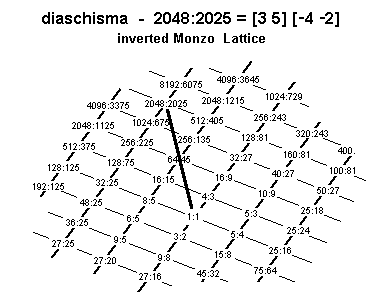1. modern usage:
The diaschisma is a small interval composed of 2 major thirds down and 4 fifths down = 2113-45-2, or [2 3 5]^[11 -4 -2].
Its ratio is 2048/2025 [= 0.20 Semitones = ~19.55256881 or ~195/9 cents].
The term was used by Alexander Ellis in his English translation of Helmholtz, On the Sensations of Tone (1875). It had been referred earlier by Rameau (Traité de l'harmonie, 1722) as the "diminished comma".
In my proposal for new names for 5-limit intervals, 100 cents and under, I suggested calling this the "sub-bipental comma" to explicitly indicate the exponent of 5.
Below is a Monzo lattice illustrating the prime-factorization of the diaschisma:

Graham Breed gives an excellent summary of Diaschismic Scales, temperaments based on the diaschisma.
2. medieval usage:
In the Expositio manus ["exposition of the hand", c.1475] of Johannes Tinctoris, the diaschisma refers cenceptually to a logarithmic half of a "minor semitone" (formerly called limma by the ancient Greeks), which is (3-5)(1/2) = ~45.11249784 cents. This interval was called the enharmonic diesis by Aristoxenos.
In actual practice in Tinctoris's day, this interval would have been calculated from an extended Pythagorean chain as two Pythagorean commas = 324 = ~46.92002077 cents. In this calculation, two diaschismata = 348 = ~93.84004154 cents, which is one Mercator's comma (= ~3 3/5 cents) larger than the true "minor semitone" 3-5 = ~90.22499567 cents. Mercator's comma would have been considered a negligible difference, thus the equivocation invoked by Tinctoris.
see also
[from Joe Monzo, JustMusic: A New Harmony]
anomaly,
unison vector,
xenharmonic bridge,
diesis,
comma,
skhisma,
5-limit intervals,
100 cents and under
updated:
2002.10.19 -- added medieval usage definition
2002.2.16 -- page created with modern usage definition only